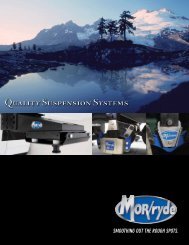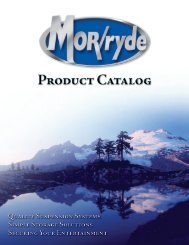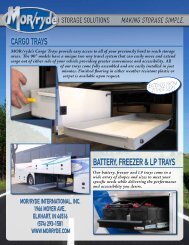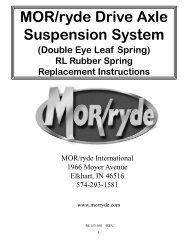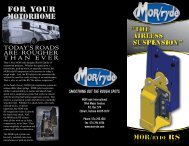MOR/ryde INDEPENDENT RUBBER Suspension System
IS Installation Instructions - MOR/ryde International
IS Installation Instructions - MOR/ryde International
- No tags were found...
Create successful ePaper yourself
Turn your PDF publications into a flip-book with our unique Google optimized e-Paper software.
<strong>MOR</strong>/<strong>ryde</strong><br />
<strong>INDEPENDENT</strong><br />
<strong>RUBBER</strong><br />
<strong>Suspension</strong> <strong>System</strong><br />
"IS” Installation Instructions<br />
<strong>MOR</strong>/<strong>ryde</strong> International<br />
1966 Moyer Avenue<br />
Elkhart, IN. 46516<br />
574-293-1581<br />
www.mor<strong>ryde</strong>.com<br />
IS153-001 REV.<br />
1
Hydraulic Shock Absorber UO109-<br />
Double Rubber Spring MO25-<br />
Hanger Assembly IS11-<br />
Torque Bracket Assembly IS20-<br />
Beam Assembly IS10-<br />
U.S.A. Patent Number 5,899,470<br />
Required Tools<br />
*Floor Jack *Jack Stands Welder Socket & Wrench Set<br />
Hammer Screw driver Torch Disc Grinder<br />
Wire Strippers<br />
* Check for Adequate Capacity. Must meet or exceed the weight of your vehicle.<br />
Specifications<br />
Torque values must be verified with a torque wrench. A calibrated pneumatic impact wrench is not an<br />
acceptable substitute.<br />
Torque Chart Torque Ft. Lbs.<br />
Bolt Size Grade 5 Grade 8<br />
1/4-20 7 10<br />
5/16-18 14 20<br />
3/8-16 25 35<br />
7/16-14 40 55<br />
1/2-13 60 90<br />
5/8-11 115 170<br />
5/8-18 125 185<br />
3/4-10 190 280<br />
IS153-001 REV.<br />
2
<strong>MOR</strong>\<strong>ryde</strong><br />
“IS” <strong>INDEPENDENT</strong> SUSPENSION INSTALLATION INSTRUCTIONS<br />
(Reusing Hub, Drum and Brake Assemblies)<br />
Measure the distance from the bottom of the frame to the top of the axle tube. This is the<br />
“D” dimension. The <strong>MOR</strong>\<strong>ryde</strong> “IS” system will need a minimum of 4”.<br />
Mark a spot on the frame, above the center of the axle tube. Do this for both sides of the<br />
frame.<br />
Measure the distance between the axles from center of axle tube to center of axle tube.<br />
Measure the distance between the top of the tires and the bottom of the wheel well. You<br />
should have at least 4 inches. Check to see if the tire has been rubbing the wheel well.<br />
These dimensions will be needed later.<br />
Remove the tires.<br />
Raise the trailer off the<br />
floor until the tires are<br />
above the floor. Raise<br />
from four corners and<br />
be sure to jack on the<br />
frame. Use a suitable<br />
jack stand or other<br />
device to support the<br />
trailer and be sure that<br />
the jack stand is rated to<br />
hold the weight of the<br />
trailer.<br />
brakes in order to get the drums off.<br />
Cut the brake wires next to the<br />
splice, if you are reusing the brakes.<br />
They will be reattached to the new<br />
brake wires.<br />
Remove the brake drums and the<br />
brakes from the end of the axle. The<br />
preferred tool to remove the drum is<br />
a drum puller. It is available at auto<br />
parts stores. To remove the drum,<br />
use a hammer and a flat screwdriver<br />
to tap the dust cap off.<br />
Remove the cotter pin from the end<br />
of the spindle. Remove the nut and<br />
washer from the end of the spindle.<br />
You may need to back off the<br />
IS153-001 REV.<br />
3
Remove the bolts<br />
& nuts that hold<br />
the brake<br />
assembly to the<br />
end of the spindle.<br />
The whole<br />
assembly should<br />
now come off.<br />
You should now have only the spindle remaining on the end of the axle.<br />
IS153-001 REV.<br />
4
Cut off the leaf spring hangers that hold the axle to the frame. Be careful to not damage<br />
the trailer frame when doing this. Support the axle with a floor jack or other suitable<br />
device so it will not fall.<br />
Remove the axles. Grind all of the rough weld that remains.<br />
IS153-001 REV.<br />
5
If the tires were rubbing on the top of the wheel well, (see the top of page 3), or there<br />
wasn’t at least 4 inches of clearance between the axle and the bottom of the frame, you<br />
will need more clearance. Weld the appropriate amount of tubing to the bottom of the<br />
frame. For example, if your “D” dimension was 6”, you will need to add a 2” tube. If<br />
your tires were rubbing in the wheel well you should add enough tubing to the bottom of<br />
the frame to provide adequate tire clearance.<br />
Place the <strong>MOR</strong>/<strong>ryde</strong> system under the frame and raise it with a floor jack, or other<br />
suitable device, up to the frame. Measure 14 inches from the front edge and make a mark.<br />
This should be aligned with the axle center mark you made on the frame earlier.<br />
Original axle centerline. Front of trailer.<br />
Measure<br />
from<br />
here.<br />
Tack<br />
weld the<br />
axle to<br />
the<br />
frame.<br />
This will<br />
hold it in<br />
place<br />
while the<br />
clips are<br />
welded<br />
on.<br />
IS153-001 REV.<br />
6
Locate the front of the new axle mounting plate and measure back the distance equal to<br />
the original wheelbase, (e.g. 33” or 35”). Draw another line on the frame. Position the<br />
front of the second axle at this point.<br />
Measure from this point.<br />
Front of trailer.<br />
Measure to this point.<br />
Tack weld this axle to<br />
the frame.<br />
Bolt on the clips to the front and rear of both axles. Snug up the bolts. Weld the clips to<br />
the frame on three sides of the clip. Do not weld the clip in the area where it is bent as<br />
this will weaken the bracket.<br />
Clips to<br />
be<br />
welded<br />
onto<br />
frame.<br />
IS153-001 REV.<br />
7
Using the shock template, weld on the shock clips to the frame. Attach the shocks at this<br />
time.<br />
Shock clips<br />
installed.<br />
Reattach the brake<br />
assembly to the spindle<br />
with the bolts that were<br />
removed. If the bolts<br />
were too rusty to be<br />
reused, purchase suitable<br />
replacement parts. The<br />
brake assemblies have a<br />
left and a right hand. The<br />
brake wires should come<br />
out of the back of the<br />
assembly so that they are<br />
on the rear side of the<br />
spindle. This will ensure<br />
that they are properly<br />
Replace the drums, wheel bearings, washers and nuts on the end of the spindles. Do not<br />
over tighten the wheel bearings. They should allow the drums to spin freely but not let<br />
the drums rock back and forth. Replace the cotter pin and dust cap. If the wheel bearings<br />
need grease please apply before reassembling them. Re-wire the brakes at this time.<br />
Bolt on the tires and wheel alignment equipment at this time. Wheel alignment is done at<br />
<strong>MOR</strong>/<strong>ryde</strong> with a Hunter<br />
Laser Alignment model<br />
R611. It can be done with a<br />
comparable machine. The<br />
Toe should be approx. +/-<br />
.010” to +.060”. the camber<br />
should be approx. +.5 deg. to<br />
+ 1 deg. After wheel<br />
alignment set the trailer back<br />
down on the floor.<br />
IS153-001 REV.<br />
8



